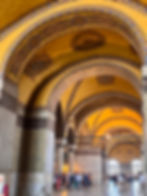

Day 3: Sacred Spaces, Sea Breezes, and the Taste of Home
Jul 12
3 min read
0
0
0

After another delicious breakfast overlooking the Bosphorus — a quiet ritual that was already starting to feel like home — we set off for one of the most iconic landmarks of Istanbul: Hagia Sophia.

Originally built in 537 AD as a Byzantine cathedral, Hagia Sophia has lived many lives — as a church, then a mosque, then a museum, and now, once a
gain, a mosque. It is a masterpiece of architecture where layers of history visibly overlap, and where Christian mosaics still whisper beneath Islamic calligraphy. This sacred space, rich with both beauty and contradiction, holds a deep presence — you can feel it the moment you step inside.



Out of respect for Muslim customs, we women covered our hair and made sure our shoulders and legs were modestly covered before entering. Inside, we wandered quietly, letting ourselves be enveloped by the scale and atmosphere of the place — the vast domes, shafts of light, echoes of prayer, and the undeniable weight of centuries that hang in the air.

Toward the end of our visit, we gathered quietly. One of our mentors gently guided us into a circle for a short meditation. Holding space within such a profound environment, while the world moved quietly around us, felt unlike anything I had experienced before.
There was a small incident surrounding this moment — something delicate that I will not go into here — but in the end, it resolved with understanding and grace. It became an unexpected part of our shared learning, a moment of vulnerability and connection that brought us closer together.
Back at the hotel, we had another generous lunch — delicious, as always, and copious enough that we questioned if we’d ever feel hungry again.
In the afternoon, our retreat program continued, this time in a new location by the sea. The fresh air and rhythm of the waves brought a different energy to our work, more open, more spacious.

In the evening, our plan was to visit the Egyptian Spice Bazaar, a vibrant market known for its scents, colors, and history. Originally, we had hoped to visit the Grand Bazaar, but it was closed in observance of Eid al-Adha (Kurban Bayramı) — the "Feast of Sacrifice," one of the most important Islamic holidays. How special it was that our visit coincided with such a sacred time.
We made our way through the town at a gentle pace, winding through narrow streets.


But when we arrived, we found the Egyptian Spice Bazaar closed as well. Plans changed again.

Instead, we continued walking toward the Galata Bridge, where dozens of fishermen stood in a row, casting lines into the water with quiet patience. It was a fascinating scene — somehow timeless and comforting.


There, we tasted something simple but unforgettable: grilled mackerel sandwiches, known locally as balık ekmek. Served on fresh bread with lemon, onion, and greens, it was unexpectedly delicious — and surprisingly nostalgic. For many of us, it brought back memories of home, especially of saba sandos (grilled mackerel sandwiches) from Japan. The joy was unanimous — everyone agreed it was a highlight of the day.



That evening, we dined out at a beautifully designed restaurant linked to the Basilica Cistern — one of the ancient underground water systems of the city. The interior was elegant, with soft lighting and timeless decor, and the food… exquisite. We sipped Turkish wine and shared plates, laughter, and conversation.


After dinner, we strolled slowly back to the hotel under the Istanbul night sky. At one moment, the sound of the adhan— the Muslim call to prayer — echoed gently through the air, giving the city an almost otherworldly stillness. It was as if time paused for a breath.


Today was full — both outwardly and inwardly. Sacred spaces, shared meals, unexpected changes, and gentle moments of reflection. The program had its delicate, emotional layers, and yet it held us all in something greater.
We went to bed full of impressions, sensing that something meaningful was unfolding — both around us and within us.



































